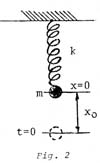|
Let
D be a physical process defined as follows: closing a hand and moving it
down in the gravitational direction a distance X0 and then, opening the
hand. D is an arbitrary process. That is, it has no definite relation with
the system S. If, in the process D, the closing hand grasps the particle
of the system S, we say that the process D and the system S are coupled.
Or S dwells on (attaches to) D. Only when S dwells on D, oscillation
occurs. And then the particle moves up and down. The pair ( , X) forms an
environmental disturbance to the system S. Consequently, oscillation
results. It is seen that dwelling is the key factor without which there is
no oscillation. , X) forms an
environmental disturbance to the system S. Consequently, oscillation
results. It is seen that dwelling is the key factor without which there is
no oscillation.
For
a given  , the particle oscillates with a constant frequency f = (1/2 , the particle oscillates with a constant frequency f = (1/2 )
k/m. The frequency is independent of the disturbance and a nature of the
system. Again this example shows: )
k/m. The frequency is independent of the disturbance and a nature of the
system. Again this example shows:
A)
The nature of the system is independent of the disturbance.
B)
Without the disturbance, the nature of the system cannot be determined.
Beside
the above two conclusions which have been previously observed, the example
demonstrates the importance of the linkage which we call dwelling. The
oscillation of the system is not due to the existence of the process D but
due to the dwelling of the system on the process. This is also true for
human beings. Without dwelling on the process, there is no mark in one's
mind. Without a mark in one's mind, where do afflictions come from?
The
effect of the dwelling of the massspring system on the process can be
dramatized if the process D is a harmonic one. This is called a forced
oscillation. When the frequency of the harmonic process D is equal to that
of the system S, the displacement X goes to infinity in theory. This is
called resonance. In reality, the displacement will not go to infinity,
but it departs from its normal, regular pattern. It is similar for human
beings. When a person attaches to marks, afflictions are produced; and
continuous attaching to them may also produce violent behavior if the
character of the involved person and the marks satisfy certain relations.
This is a behavioral resonance, and we say that the person is angry, mad,
crazy, or insane. To express the character of the person, we call it
demon, ghost, devil, or unwholesome spirit.
The
analogy between the oscillation and human behavior has a subtle meaning.
Let me explain it so that one can see the importance of realizing his
self-nature. We take the natural oscillation of the system S as accepted
normal behavior. When the system S dwells continuously on the
environmental process D, the natural oscillation is altered. If they are
in phase, resonance is produced. In the same way, when a person dwells on
marks, his mind is distorted and his behavior departs from the norm. The
self-nature of the person always tends to bring his misconduct and
distorted mind back to the normal. However, when he dwells on the marks in
phase, behavioral resonance is produced and he completely departs from his
self-nature. He has lost himself and is insane.
It
must be noted that when a person is in behavioral resonance and insane,
his mind has become confused and his conduct departed from the norm; yet
even then his intrinsic self-nature remains intact. It is still pure and
clear; it is still in constant stillness and constant illumination. The
self-nature of an insane person is the same as that of a sage or a Buddha. |
